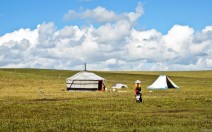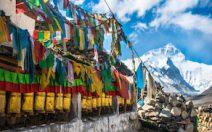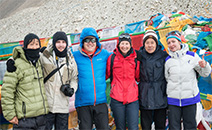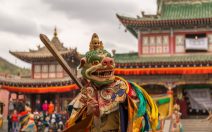Ralung Monastery
Ralung monastery is about 200Km from Lhasa. On the way to Gyantse, after crossing Kora La pass, will reach Ralung monastery at 6Km east from the main road between Nagartse and Gyantse. This monastery was first founded in 1193 by Drogon Tsangpa Gyare. Ra means goat and lung means prophesy in Tibetan. Therefore, Ralung literally means The Prophesy of Goat as it was believed that the site was prophesied by a white goat to build a monastery.
The main school of Ralung monastery is the Kagyu sect of Tibetan Buddhism. There a lots of chapels, each having a main statues of different buddhas and Dhrama protecting deities respectively.
Samding Monastery
The Monastery is said to be built in 13th century. This is also home to a female incarnate lama – Dorje Phagmo. The sanding Monastery is on the rocky hill besides Yamdrok Yumtso Lake. The monastery is only 10km to the east of Nagartse. A truck stop town where many tourist have lunch at this place.
Yamdrok Lake
Yamdrok Lake or Yamdrok Yumtso Lake in Tibetan meaning the lake of turquoise. This lake is one of the 4 sacred lake in Tibet. Many Tibetan believe that soul of Tibet rises from this lake. This lake is one of the highlights on the way to Mount Everest or Nepal border from Lhasa. You can stop right at the shore of the lake. But you may have a great view from distance before you reach to the shore.
Karo – la Glacier or Karu – la
The karo-la Glacier has been melting dramatically in the recently years since the highway built right below the glacier. However, it’s still a worth well to stop by and have a close look at the Mt. Nojin Gangzang.
Old Gyanste County
Old Gyanste County was situated in the middle of Gyantse town, little elevated on a hill top. It got a unique and beautiful view from far away. Old and ancient style of the county was first initiated around 976 by king Palkhor, a relative of last empiric lineage of Tibet, after whom Tibet got divided into small princely states.
County was further expanded during the overlord political role of Phakdrupa (Sakyapa order). Earlier it used to have four temples at every four directions of the county but presently we have the east temple with repaired mural paintings inside. On every 10th and 25th lunar date, it was open for locals to visit.
Gyantse Palkor Choede
Palkor Choede is a small monastic school at 90Km east-south of TashiLhunpo monastery from the main road of Gyantse county and 230 Km away from Lhasa. Gyantse Palkor choede was founded in 1918 by Rabten Kunsang, who had once been a sheriff of Gyantse County. The assembly hall is main part to explore and it was built with the size of 8 tall pillars and 48 short ones. The supreme statue of the shrine or the hall was that of Jowo Mahabuddhi. Instead of usual wall paintings and large wheel of life mural, the entrance is decorated with the four guardian kings. First chapel to the left was the house of five Jinas. East chapel was consist of a statue of Jampa (Maitreya) being the central image and beside was the statue of Avalokiteshvara, surroundings were Manjushri, Vajrapani, Guru Rinpoche and trio of Dharma Kings.
In every fourth lunar month, monastery will held a religious festival during which monks will perform a tantric dance as well. On 18th day, there was a unveiling of huge thangka of buddha for which hundreds of devotees will visit for bless. And there will have another activities like Gyantse Horse racing and Arrow contest which will make the day more festive.
Tashi Gomang Pagoda of Gyantse Palkor Choede
This huge and unique Tashi Gomang stupa was built by Rabten Kunsang in 1476. It was eleven stories tall with four levels. First level with four big gate doors at each directions, at the south was Gautama Buddha, Buddha of infinite life at west, Dipankara (Buddha of past) at north and future buddha at the east. Similarly, each of other three levels have four main doors at each east, west,north and south respectively dedicated to different buddhas. This tower like stupa consists of hundreds of buddha icons, making it a significant feature of Palkor Choede monastery and overall it has 90 chapels in layers.
Gharu Nunnery
It was in 1987, Gharu nunnery was founded by Mr Thupten and other devotees. It was built upon a small hill pass called Gharu La pass and it was how nunnery got the name as well. The nunnery was built under the good deeds of Bikshu Uthpal. ( fully ordained monk ). Initially a stupa was built with the garments of Bikshu Uthpal as a relics inside and an image icon of Guru Rinpoche. Later on, beside this, another three Stupas were also built. And then nunnery was founded with the image of Avalokiteshvara and Trio of Spiritual Father and Son as the main icons in the congregation hall.
Lhatse Choede in Lhatse county
Lhatse is a county next to Shigatse city and Lhatse Choede is a small Gelugpa monastery in Lhatse County about 11km from Dangmoche town. Lhatse Choede was founded in 17th century under the counsel of fifth Dalai Lama. It follows the traditions of Deyang monastic school of Drepung monastery at Lhasa and their abbotship was also appointed from Deyang Collage. During the 6th Dalai Lama Jamphal Gyatso, Lhatse Choede became under the TashiLhunpo Monatery at Shigatse. Before it has around 500 monks and follows both the philosophical and practical traditions of Tibetan Buddhism. The main icon in the assembly hall was a gold-brass statue of the medical Buddha. And there is a clayed image of Maitreya Buddha in Jamkhang (the chapel of Maitreya).
About 5km walk from the monastery to the east. There are temples, other small monasteries and a repaired tomb of kings that can be visited.
TashiLhunpo Monastery in Shigatse
Tashilhunpo monastery was founded in 1447 by Gendun Drup, the first Dalai Lama. Monastery was the traditional seat of successive Penchen Lama. The construction of Tashilhunpo monastery was financed by donations from local nobles and benefactors. It was during the fourth penchen Lama, who made major expansions to the monastery. Since then all Panchen Lamas have resided at Tashilhunpo, and have managed to expand it gradually. Tashilhunpo monastery has four major monastic schools under its command. The main chanting hall contains the Throne of the Penchen Lama with two connected chapels, one for Sakyamuni and one dedicated of Tara the protector deity.
Dechen Podrang in Shigatse
Full name is Dechen Kelsang Podrang. It is the seat Palace of the Penchen Lama lineage. It was about one kilometer south from TashiLhunpo monastery. This Palace was built in place of Kunkyop Protang (seat palace before Dechen Protang) which was completely flooded in 1954. So starting the project in 1955, Dechen Protang was successfully built by professional architectures specially invited from Beijing and Tibetan professional craftsman under the full advice and visions of 10th penchen Lama. The palace has schools, office, Chapels, sacred rooms which all made it very special palace in entire Tibet.
Shalu Monastery in Shigatse
Shalu monastery is small monastery 22 km south of Shigatse City. Founded in 1003 by Jetsun Sherab Jungnay, an eleventh-century Tibtan abbot and scholar. He wish to found a monastery under his name and asked for his tutor.Tutor asked him to fire an arrow and trust to the goodness and wisdom of Buddha that it will find the perfect location. Where the arrow landed would become the most central point of the foundations of the monastery. Therefore, arrow landed on the present site of the monastery. So monastery was originally build with the initiation of a small temple called Yumlhakhang, enshrined with scripts of 12 Yum manuscript and the statue of 41st king Tri Ralpachen. In 1329 a devastating earthquake demolished the temple of Shalu but was later rebuilt in 1333 by local lords under the counsel of the Mongol Emperor and later Shalu Temple was owned by 11th Abbot Boton Rinchen Drub who lived 1290–1364. He expanded the monastery with lots of Monastic shools and successfully runed the Shalu monastery for almost 36 years. His activities in Shalu monastery inevitably attracted a great deal of attention to the monastery and brought in other Buddhist intellectuals around Tibet. Shalu became the first among the major monasteries and learning centers during Tibet’s great revival of Buddhism and an important center of the Sakya tradition.
Narthang Monastery in Shigatse
Exiting 10km south of the main road from Tashilhunpo to Samye was Narthang Monastery. It was Founded in 1153 by one of the disciples of Atisha. Narthang was first famous for its scriptual teaching and monastic discipline and it produce many of Tibetan scholars around Tibet. In 12th century, many scholars collect and arranged three sacred manuscripts of Tibetan Buddha’s teaching.After the fourteenth century it gained great eminence as the oldest of Tibet’s three great printing centers others being Potala and Dege Printing house. In 1732 under the benefactor some local lords, monastery curved 100 Kangyur scripts and 200 Tengyur scripts in a wooden printing blocks and hundreds of other scripts. Originally it has 13 chapels and two monastic schools. The printing house contained 130000s of woodblock prints. The assembly hall has the history of gathering ten thousand monks at a time. The 108 pillared hall was enshrined with Maitreya Buddha, Bodh Gaya or Mahabodhi Temple and Gold-brass statue of Buddha.
Presently, in a restored 12 pillared assembly hall, indeed there are statues in place of earlier ones and out of 13 chapels, you can visit most of them in a restored style. There are about 8000 woodblock prints today.
Sakya Monastery
Sakya monastery is most sacred Sakyapa monastry situated 25 km southeast of Gyatso la pass which is about 140 km west of Shigatse on the road to Tingri. And it was The seat of the Sakyapa school of Tibetan Buddhism, founded in 1073 by Konchok Gyelpo and was enthroned as the first Sakya Trizin ( The throne holder of Sakyapa tradition). The monastery has about 108 temples and chapels. Since from 1262, Drogon Chogyal Phagpa, (the fifth leader of the Sakyapa school)played his overall political role of Sakyapa order in Tibet and made major improvements and expansions of the monastery.
Ogyen Lhakhang
Ogen Lhakhang monastery is at 2-3Km southwest of the Sakyap monastery. It was founded in 8th century by Nyodup Palbar. This monastery hold one of the four most sacred image of Guru Rinpoche in entire Tibet. Ogyen Lhakhang monastery was originally a Nyingmapa tradition however it was a Sakyapa monastery today.
Shelkar Choede monastery and Shelker Dzong
Shelkar Choede monastery was about 46Km away from the main of old Shelkar County. This old monastery had a history back in 14th century, around which the monastery was founded as a small temple with first initiation. It was built by a Southern lord Situ Rinchen, whose father was a kind of local lord, who fought with a local northern king, was defeated and conquered by northern lord. Situ Rinchen was enslaved by northern lord but later he fall in love with the daughter of northern king, so he became a part of them and own a small county called Tashi Dzong. Later on, he also founded the old Shelkar County.
Since he was a devoted person, he honored a great saint who stayed there at the site of present Shelkar choede monastery. Therefore, under the words of his devoted guru or saint, Situ Rinchen founded the Shelkar choede monastery. At the first initiation, there were around 15 monks, but later on it got expanded into monastic schools within it, Sakya sect, Kadhampa sect with 800 monks. However there happened controversy among different sects. During 17th century, at the time of 5th Dalai Lama, monastery was confirmed and authorized as a monastery of New Kadhampa sect, Since then it become a monastery of Gelugpa sect with around 300 monks in it. Monastery has 21 chapels housed for different deities, buddha images and icons.
The site of monastery was highly recommended for its beautiful surroundings, at the bottom, there follows a four big rivers, at the east was Sakya monastery and south to it was mount Everest. Also there were print house and hermitages that can be visited at 24km from the monastery.
Rongbuk Monastery
Ronbuk monastery is the highest monastery in the world, elevated at 5100m above sea level. Monastery is about 90Km from the its nearest Shelkar town and 8km from the Everest Base Camp. Initial and historical site of Rongbuk monastery is at 4km from the present Rongbuk beside the route to mount Everest. Where Guru Padmasambhava stayed one month and seven days there and his meditation cave can be seen these days as well. During his stay, he subdued five evil spirits and established them to be as a protector of Dharma indeed. Later on, this site had been a holy place of many masters and meditators, about 108 caves had been built respectively.
Original Rongbuk monastery was founded by Nyingmapa Lama Ngawang Tenzin Norbu ( Root lama of Rongbuk monastery ) in an area of meditation huts and caves that had been in use by communities of nuns since the 18th century and gradually it became a monastery of about 900 monks and nuns. However present Rongbuk is not as original as it had to be, Rongbuk monastery was completely destroyed by 1974, and it was repaired upon the ruins left. Presently there are only about 20 nuns and 10 monks, although previously there were about 500 monks and nuns living here.
Mount Everest
Mount Everest is the highest mountain on earth and Its peak is 8,848 meters above sea level. First Base Camp of Everest is about 8km, from Rongbuk monastery, There are buses that will take you to the base camp, however many choose to walk, intending to have more views and and natural experience. At base camp, there are restaurants, yak hair tented guest houses and a hill top, from which people use to enjoy the graceful view of oblate Mount Everest and take pictures there.
Gyetong Monastery
Gyetong Monastery can be visited at 30km south from the main road to Thingri. Monastery was founded by a great saint, Bhivaka. During the overall role of Sakyapa in Tibet, Drugon Choegyal Phakpa, a great master who founded the Sakyapa sect of Tibetan Buddhism came to visit the monastery and he built the root of Sakyapa school in Gyetong monastery. Later on monastery practice the Nyingmapa principles as well. The assembly hall was noble and scared for naturally appeared image of the Bhivaka on a stone and golden built icon of Drogon Choegyal Phakpa.
Nowadays, after its repaired constructions, indeed there were huge thangka image of Bhivaka, clayed figure of Drogon Choegyal Phakpa and brass-golden icon of Jowo. And in the upper chapel of Jampa, there was a clayed icon of Maitreya Buddha. Every year, on 19th of 9th lunar month monastery would perform the Buddhist tantric dance. And about one hour walk from the monastery, there was a nunnery called Red Clift Nunnery that you can visit.
Nyalam Gephal Ling / Melarepa’s Cave
This monastery is about 10Km from present Nyalam County, just below the Jangling town. In 11th century, Milarepa a Tibetan magician and poet, did his meditations there at the site of present monastery. These days there are ruins of his cave, bowl, foot and hand prints inside the cave can be visited. Initially Nyalam Gephal Ling was built as a Kyagyu school monastery but in 17th century, fifth Dalai lama converted them in Gelug (yellow hat sect) and since then it was a Gelugpa monastery under Sera monastery at Lhasa. It has around 40 monks and abbot of this monastery was appointed every year from Sera monastery. These days, in repaired chapels you can visit the image of Milarepa, icon of Jowo and Milarepa’s cave with so many naturally appeared omens. Gyephal monastery had a custom way of holding the festivals regarding the life of Milarepa.
Tibet to Nepal Transit
Your Tibet Tour ends at the border town of Dram or Zhangmu in Chinese. You can exchange your left Chinese Yuan to Nepalese or Indian Rupee or USD. After you made the farewell to your Tibetan guide and driver. You are heading to the immigration office. The Nepalese Immigration Office is near the Friendship Bridge. And you can obtain Nepal visa at the border. From the border there are 2 major ways of getting to Kathmandu. hire a private Jeep or Taxi. There are buses available but not recommended as it is one of the thing you want to see but don’t want to experience. Anyway, different kinds of transportation are waiting to pick up guests from Tibet at the Kodari. Start your adventure in Nepal.





